Table of Contents
Toggle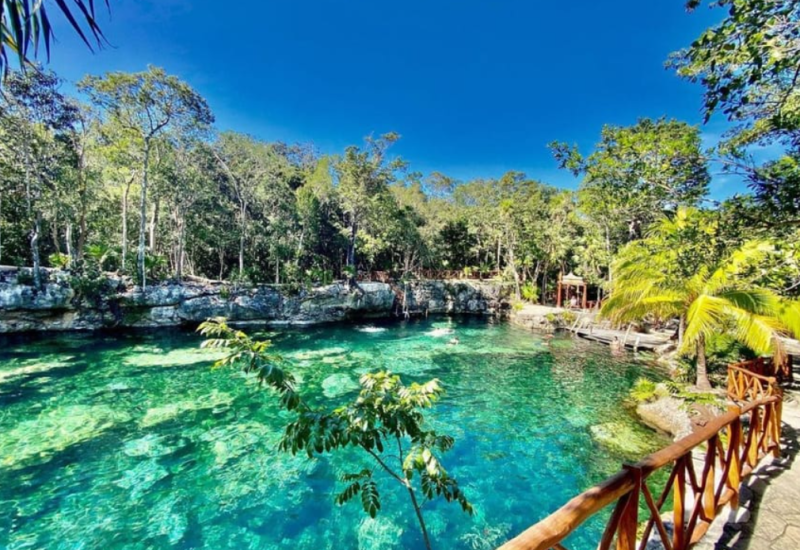

If you’re exploring the Riviera Maya and craving a more authentic, less crowded cenote experience, Cenotes Casa Tortuga is a hidden gem you won’t want to miss. Tucked between Tulum and Playa del Carmen, this natural park offers a refreshing escape into crystal-clear waters and lush jungle surroundings.
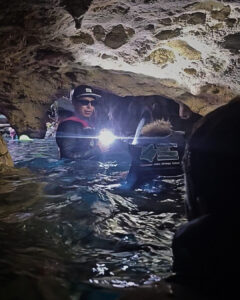
Casa Tortuga’s four cenotes tell stories of ancient Maya faith and Earth’s distant past. The Maya saw these clear pools as doors to Xibalba, a watery underworld where they offered jade, gold, pottery, and even human lives to the rain god Chaac. Long before the Maya, a huge asteroid struck the Yucatán around sixty-six million years ago which cracked the limestone ground. Over millions of years, slightly acidic rainwater widened those cracks into large caves; when the cave roofs gave way, they revealed the clear ground water you can swim in today. Casa Tortuga is part of a network of more than six thousand cenotes that still feed the peninsula’s fresh water supply and carry the echoes of Maya ritual and life-giving water.
You’ll take a guided tour that brings you to four unique cenotes, each offering a different experience along the way:
Cenote Campana: A semi-open cenote where you can swim through cool, shaded waters surrounded by ancient stalactites hanging from the ceiling and stalagmites rising from the cave floor. The atmosphere is magical- and just a little bit eerie- as you navigate narrow passages and echoing chambers that feel like another world.
Cenote Wisho: This cave cenote features a passageway where you can admire several fossils and observe the natural habitat of bats, adding an element of adventure to your swim.
Cenote Dorca: An open cenote with depths ranging from 10 to 16 feet, offering multiple platforms of varying heights for jumping. It’s a favorite spot for those looking to add a splash of excitement to their visit.
Cenote Tres Zapotes: A long, open cenote extending over 100 meters, known for its incredibly clear water. Here, you can take the plunge from a 3-meter-high platform into depths of up to 8 meters, making it a must-visit for thrill-seekers.
The tour usually lasts about 1 hour and 40 minutes, guided by local experts who share stories about the geology and cultural significance of the cenotes. After the guided tour you can explore on your own.
*Don’t forget to tip your guide if they do an excellent job.
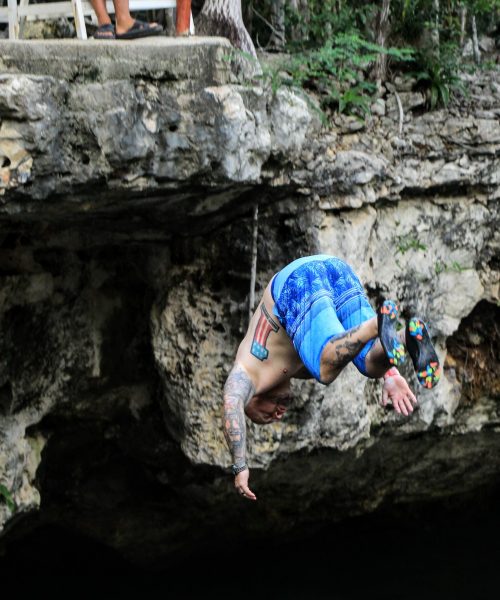
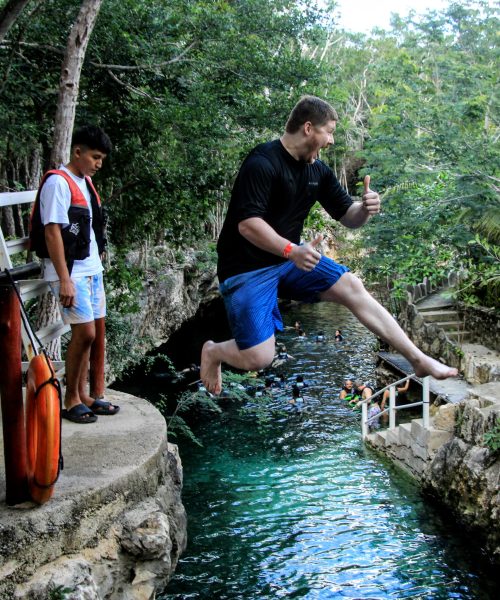
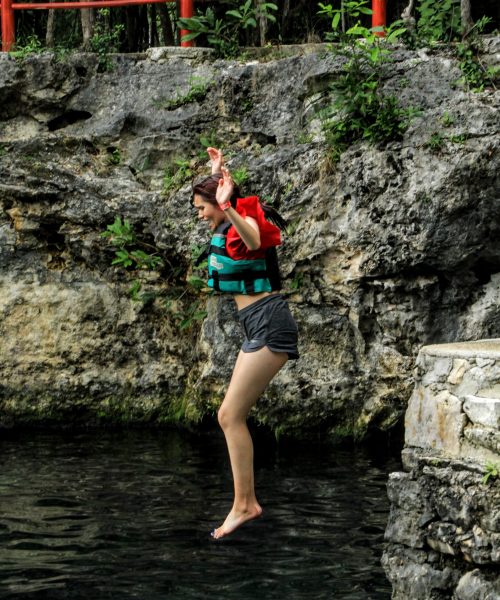
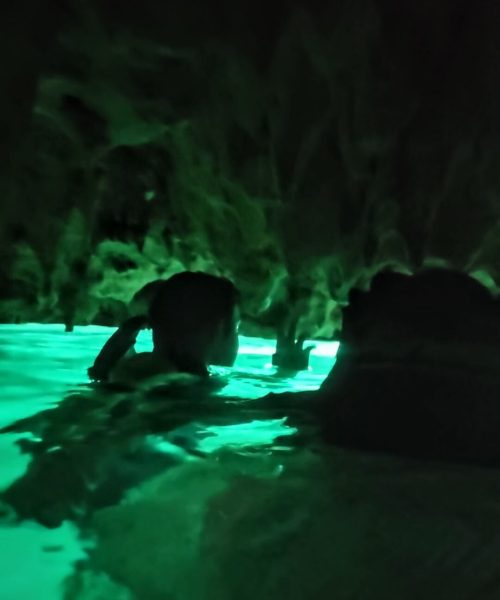
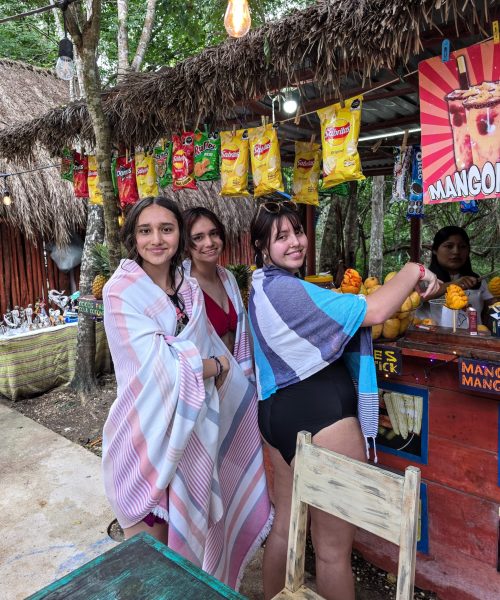
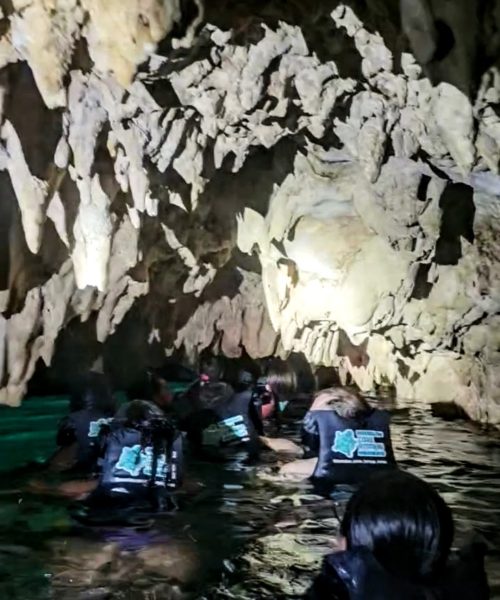

The park is open daily from 9 AM to 5 PM and offers free parking, showers, and restrooms. On-site, you’ll find restaurants, cafés, a bar, and even a pizzeria – great spots to grab a snack or a cold drink. Outside food and drinks aren’t allowed, so consider eating beforehand if you’d rather not purchase food on-site. Locker rentals are available for around $5 USD.
If you’re looking to add a little adventure, optional activities like zip-lining, ATV tours, and kayaking are available for an extra fee (subject to availability). The park also offers beginner-friendly diving experiences in one of the open cenotes for those curious about exploring underwater.
• Rent a car – about 33 USD per day; free parking at the entrance
• Taxi – 150–300 MXN (≈ 8–15 USD); confirm fare before departure
• Colectivo – 40 MXN (≈ 2 USD); catch a north-bound van heading toward Playa del Carmen and let them know you are heading to Casa Tortuga. You will be dropped off at the shoulder then need to cross the highway and walk about 10 min to the main entrance.
From Playa del Carmen (≈ 52 km south, 40 min)
• Rent a car – about 40 USD per day for a small car; straight shot down Highway 307
• Taxi – 600–800 MXN (≈ 30–45 USD); agree on fare in advance
• Colectivo – 60 MXN (≈ 3–4 USD); take a south-bound van toward Tulum, expect drop-off on the highway shoulder and a 10-min walk to the entrance; vans can be crowded
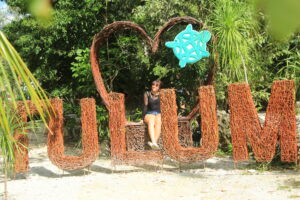
During the tour, staff photographers take action shots of you enjoying the cenotes. The prices are a bit high, but the quality was surprisingly great. I ended up buying a few and tipped the photographer for his excellent work.
If you’d rather take your own photos, bring a waterproof and floatable phone case so you can capture the moment safely. This place is unforgettable, and you’ll want to have photos to remember it by.
Admission: I’ve seen the basic guided tour prices range from $15 to $40 USD, depending on the season and any current promotions. Prices can go up if you choose a package that includes extras like zip-lining, ATV rides, or meals—so what you pay ultimately depends on the experience you want.
Age considerations: Children under 5 enter free; kids 6 and up pay regular admission. Some parts of the cave cenotes involve swimming through underwater passages, so it’s best to consider this if you have very young kids or anyone uncomfortable in tight spaces.
No outside food or alcohol is allowed inside the park, but you can enjoy their food services.
Bring a waterproof case for your phone or waterproof camera if you want to capture the incredible underwater views.
Cenotes Casa Tortuga delivers an authentic, less commercialized, and more affordable experience that showcases the natural beauty of the Riviera Maya. Whether you’re swimming beneath ancient rock formations, floating in the crystal-clear water, jumping from a platform, or simply enjoying the peaceful jungle surroundings, it’s a deeply refreshing way to connect with nature and history.
The Riviera Maya has a tropical climate, so the dry season (November to April) is the most pleasant. Avoid peak midday heat by booking your cenote tour early in the morning or late in the afternoon.
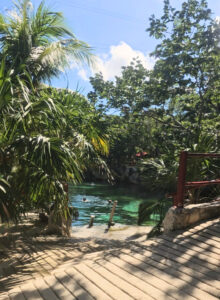
A quick-dry towel
Water shoes (helpful on rocky or slippery terrain)
Waterproof bag or dry sack
Small cash bills for tips, lockers, or extra snacks
No Sunscreen or Insect Repellent are allowed
Book in advance during peak travel months (especially December–March and around Semana Santa).
Consider combo tours that include Casa Tortuga plus Tulum ruins or nearby cenotes.
Check for discounts or promotions on local tour sites or apps like GetYourGuide or Viator.
Cenotes are fragile ecosystems. Avoid wearing makeup or lotions, and always shower before entering the water if requested. Even eco-sunscreen can affect the water’s natural balance.
Currency: The Mexican peso is the local currency. Many places near Casa Tortuga accept credit cards, but it’s smart to bring some pesos for tips, food, or colectivos.
Language: Spanish is the official language, but many tourist areas speak English well. A few Spanish phrases go a long way in showing respect.
Connectivity: Mobile signal can be spotty near cenotes. Download maps offline or let someone know where you’re headed.
Safety: The Tulum–Playa del Carmen corridor is generally safe for tourists. Always use common sense: don’t flash valuables, and avoid walking alone at night in unfamiliar areas.
If you loved Casa Tortuga and want more, consider visiting:
Cenote Calavera (near Tulum): Known for its “skull-shaped” holes and diving platforms.
Gran Cenote: Popular and very photogenic, with lots of turtles.
Cenote Azul: A beautiful open cenote ideal for families.